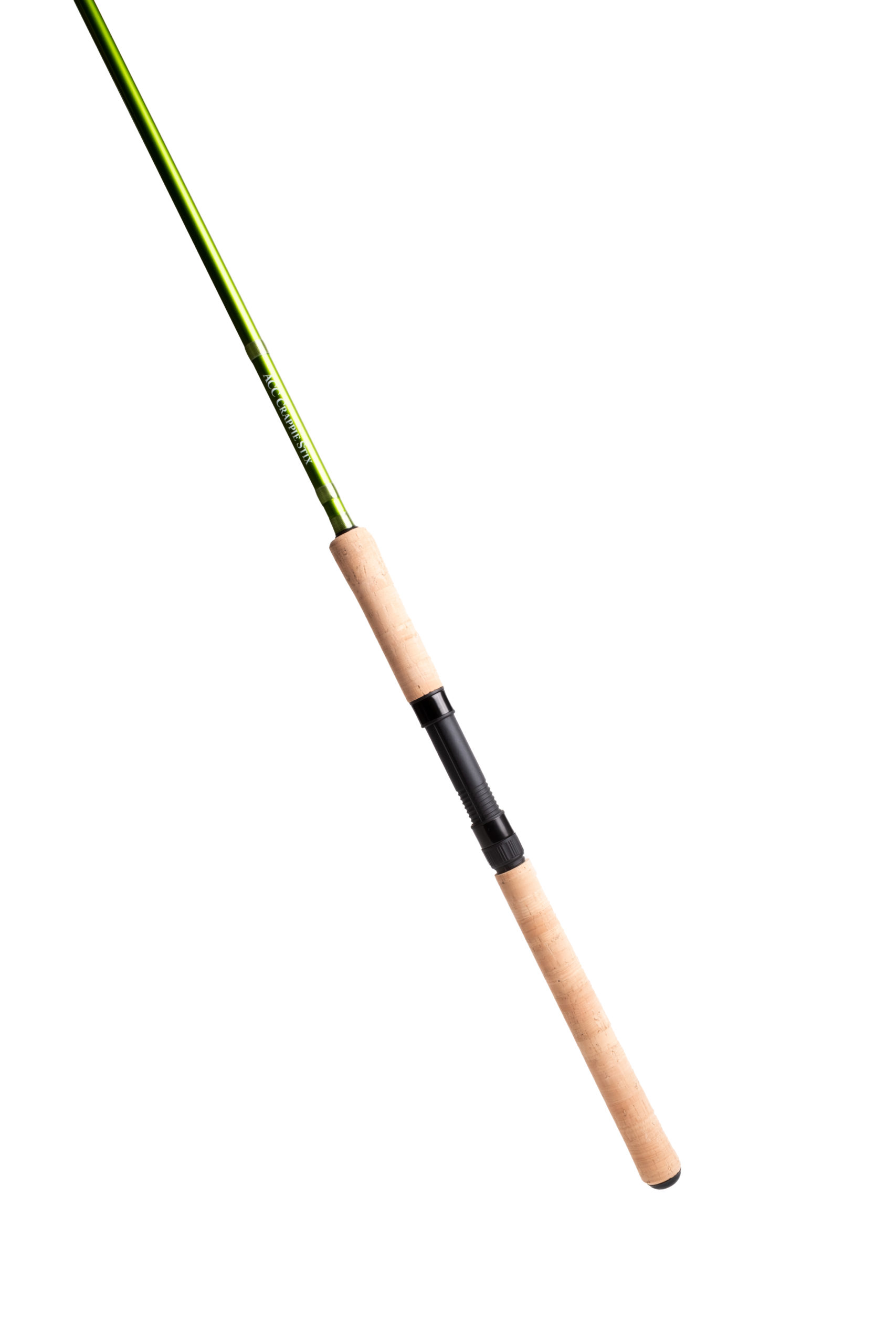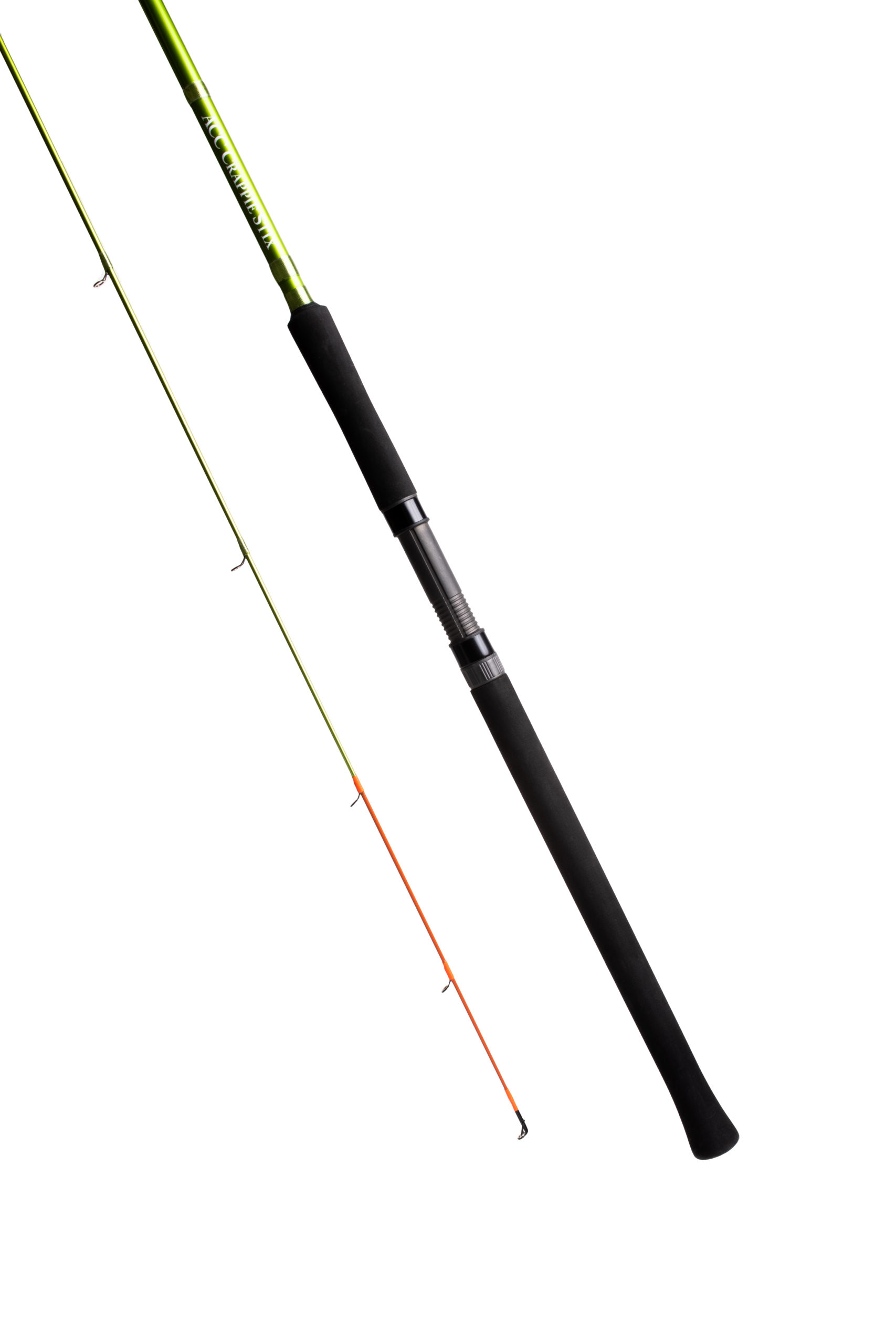Wading into Spring: The Art and Adventure of Pursuing Crappie
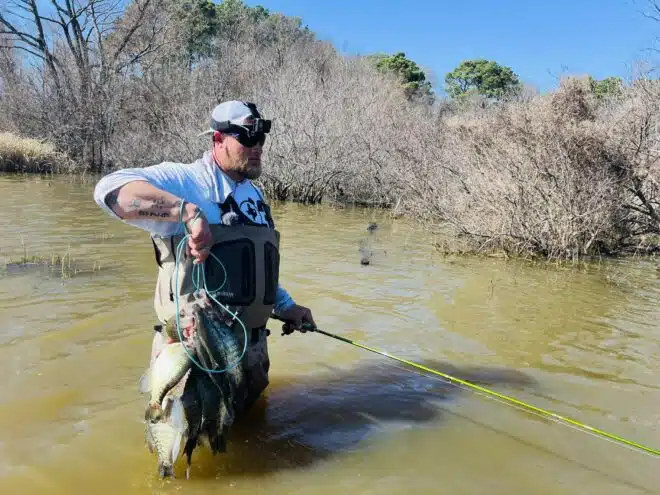
By Greg McCain
Digital creator Caleb Hensley has fished for crappie for years, but only recently has he taken the jump – literally – into wading for crappie.
In recent years, Caleb (903 Fishing on all social media platforms) ventured into the world of wade fishing for crappie on the east Texas lakes near his home. He soon found that he loved the practice and also learned that he could catch fish while wading just as effectively as he could from a boat, at least at a certain time of year.
Today’s blog segment involves when and where to find crappie while wading lakes. A later blog post involves the how-to part of the process, including the ACC Crappie Stix rods and other gear that can be used effectively by a wading angler.
Caleb has quickly become a fan even though he only recently took up the technique.
“Wading is some of the best fishing you can have and some of the most fun fishing,” Caleb said. “Wading has quickly become one of my favorite times of the year. I”ve only been wading for crappie for about three years, but once you figure them out, you can really catch them.”
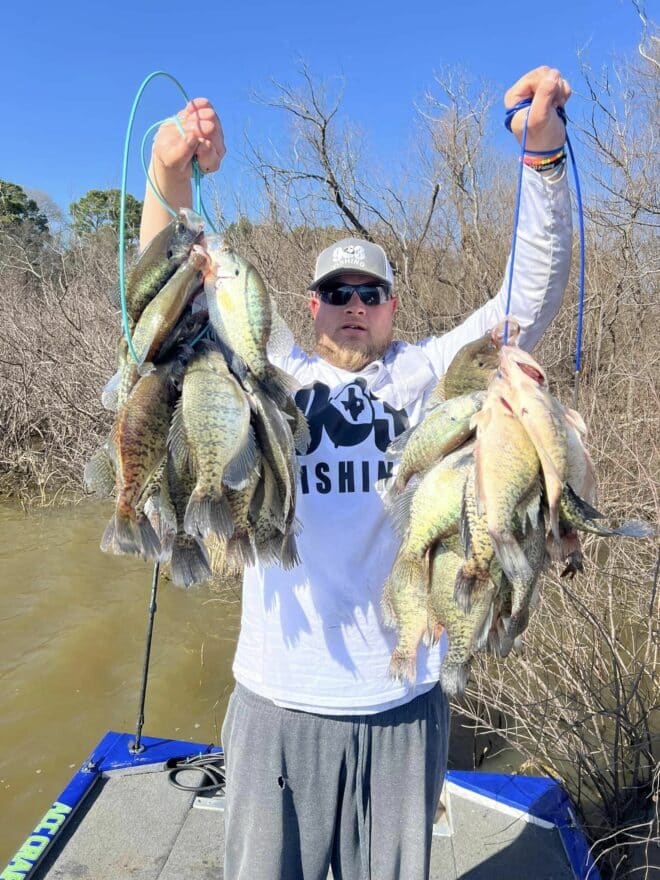
Wading for crappie is just as natural for some fishermen as launching a boat to pursue slabs. The potential recurs each year, with anglers awaiting the right water levels and temperatures for crappie to move into the shallows. They battle the elements – including some that pose physical threats – and get their spring crappie fix in the water rather than from a boat or from the bank.
The practice is a time-honored tradition in certain regions of the South. The Mississippi big-fish lakes like Grenada and Sardis are home to a legion of waders like guide Kelon Hall. He mainly wades on Sardis and awaits the rise in water levels there each year, a sign that the fish will soon moving into spawning areas, some of which can only be accessed by wading.

“If you’ve never tried it, it’s something you need to do at least one time,” he said after a trip last year, referring to the wading potential on the lakes. “It’s definitely my favorite way to fish, just being able to get in the water and being able to fish that thicker cover.”
Wading is definitely not limited to the South, however. Certain lakes that boast shallow flats and ample cover hold the potential – the acres of buckbrush on Rend Lake in southern Illinois come to mind – for productive wading.
Caleb provides an analytical overview of when and where he finds crappie shallow during the spawn, which starts as early as February in Texas and rarely lasts beyond early to middle April. March is generally a prime month for wading for Texas slabs.
“Typically, I start wading when that surface temperature reaches 55 degrees,” he said. “When I see those dogwoods start to bloom, I know there’s a chance that I can find fish up shallow. The males typically come in first and do their job. The females come in for a very short period of time, and they lay their eggs. The males actually stay and guard the fry 7-10 days or so.
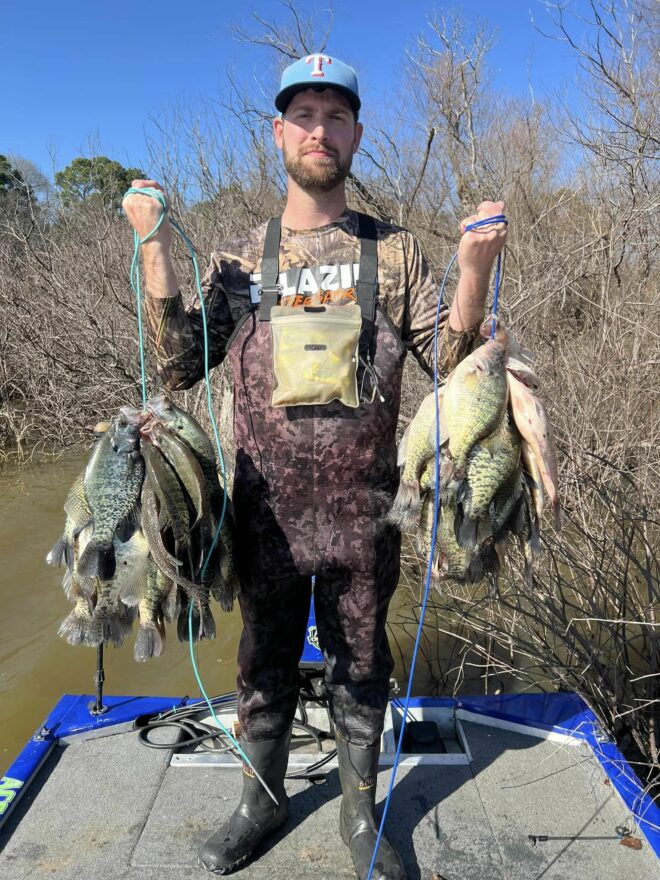
“There’s only a 4-6 week period down here in Texas when I can catch them really well. This year’s spawn started early. We had some 80-degree days back in February, and I caught my first crappie wading on Feb. 15. Typically it’s late February-early March, but the weather dictates all of that. You can’t go by ‘well, I caught them this way and this time last year.’ The weather may be different, the moon phase may be different. There could be any number of factors that play into it.”
Later, he added equally important information about his pursuit of slabs while wading during the spawn. A muddy bottom – on the northern portion of a fishery – proves to be best for locating crappie.
“I find most of my spawning fish on the northern end of a lake,” Caleb said. “I know that’s vague, but specifically, I like to find buckbrush on points.
“The most important thing, in my opinion, is mud. A lot of people say these crappie spawn on rocks and stuff, which they do. But you want to find a muddy bottom. These crappie can not fan out a bed on clay or on a rock-hard surface. I want to find a muddy bottom. I’ve caught crappie on a muddy bottom when my feet sink 2-3 inches into the mud, and I’ve also caught crappie when I sink up to my knees. If I get out of the kayak or out of the boat and my feet don’t sink into the mud, then I’m getting back in and going to another location.
“I have learned, just from experience, if you don’t have a muddy bottom, then the chances of fish being there are not very great.”
While crappie do not always spawn in the same locations from year to year, Caleb said the fish that he finds while wading do seem to gravitate back to the same places.
“There’s something about (a certain) location that brings those fish back,” he said.
In Mississippi, Kelon has been “wading” since he was too small to get into the water, his father carrying him to a likely location and leaving him fishing from a stump while others in the party waded and fished nearby.
The water on Sardis in north-central Mississippi remains low in early April for the best wading potential, but Kelon (Hall’s Guide Service, 662.316.6124, or Halls Guide Service on Facebook) finds plenty of fish by boating to a spot and jumping in to sample the wade fishing.
“It’s a little different this year,” he said. “The water is so low we’re having to use the boat more to get to more places like little flats close to the river. It’s not up in the trees. We’re hoping the water gets up into the trees, but you have to rely on mother nature and the rain to get water up there.”
The water is drawn down for flood control as much as 30 feet in the winter on Sardis and remains about 8-10 feet below full pool in early April. Until the water comes up, Kelon fishes the stump flats and the grass in the drawn-down lake. The early spawners lay their eggs on the stumps and in the various grasses that flourish until the water covers them.
“That’s a real good way to catch them when the water is low,” Kelon said. “When they don’t have as much cover to spawn on, they love the grass.”
Mississippi wading for crappie, however, is best known for treks deep into wooded swamps. One particular location, near Hurricane Landing Boat Ramp north of Oxford, MS, offers some of the best wading in a region full of great crappie-fishing potential. A boat is not needed nor even feasible for the location, which requires a wade of a mile or more at times to reach the best fishing.
“I like it when those fish get into the thickest stuff you can find, the buckbrush and those ironwood trees, places that have those vines hanging down,” he said. “That’s my favorite place to fish in the woods. That’s what I look for when the water comes up.

“It’s getting better and better every day. If we do get some more rain and the water comes up, then the fishing should be on fire.”
The fishing remains good until May. Kelon said he remembers an exceptional day of crappie fishing on May 15, but the first days of May usually mark the end of the wading opportunities.
Regardless of the location, wading for crappie certainly comes with a word of caution. Inherent dangers include snakes, gators, and taking the wrong step into deeper water. A life jacket is advised but not always used by wading specialists.
Caleb offers his own take on staying safe while wading.
“There’s always a fear (of the potential dangers),” he said. “Ninety-nine times out of a hundred, I will not go alone. Safety always comes first. Take a buddy with you and take your time. Don’t get in a rush. When I’m out there, I’m creeping. One or two inches can mean falling in a hole or tripping over a log. You just have to be careful.”
While not every crappie fishery offers the chance to wade fish for crappie, consider the potential on a local lake that provides the required habitat. Follow the advice of waders like Caleb and Kelon. A new type of crappie fishing awaits the angler willing to figuratively take the plunge.




